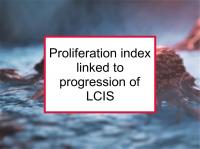Women with lobular carcinoma in situ (LCIS) are at higher than average risk for invasive breast cancer. However, the risk is elevated for developing ductal as well as lobular breast cancer and for both breasts. Therefore, for most (but not all) women, LCIS appears to be a risk factor for breast cancer rather than a direct precursor of invasive disease.
To date, efforts to predict which LCIS patients will progress to invasive breast cancer have met with little success. Now a new study has reported that LCIS with high Ki-67 (a marker of proliferation) expression is most likely to progress.
Estrogen receptor (ER) and progesterone receptor (PR) status was determined, as well as E-cadherin, epidermal growth factor (EGFR) and Ki67 expression. E-cadherin, EGFR, and Ki67 have been shown to be prognostic markers in invasive breast cancer. E-cadherins are a type of protein necessary for breast cell adhesion (they help keep the cells in breast tissue together). Loss of E-cadherin expression reduces the strength of the bonds between cells, which may enable cancer cells to invade surrounding tissues. Invasive tumors with positive EGFR expression tend to be larger, with more aggressive characteristics (including higher proliferation and genomic instability) than EGFR- tumors. Ki67 (or Ki-67) is a measure of proliferation which is routinely evaluated on pathology.
Study tested prognostic indicators used in invasive breast cancer
The study was designed to investigate the risk of progression to invasive breast cancer for LCIS patients. This was a retrospective study that included 47 women with LCIS treated at Institut Curie in Paris, France. The average age of the patients was 51.3 years. All of the women received a lumpectomy to remove the LCIS, but they did not undergo radiotherapy.
Most of the LCIS was ER+
The authors divided the lesions into the following groups: (1) ER+ and Ki67 ≤ 10%; (2) ER+ and Ki67 > 10%; (3) ER-; and (4) ER-/PR- and EGFR+. All but two of the lesions were classical LCIS. Among the 44 evaluable cases, 34 were ER+ or PR+ with Ki67 ≤ 10%, 9 were ER+ positive with Ki67 > 10%, and one was ER-/PR- and EGFR+. E-cadherin turned out not to be a useful prognostic indicator since all of the LCIS lesions were either E-cadherin negative (71%) or E-cadherin weak and incomplete (29%).
Ki67 predicted progression to invasive breast cancer
All of the study participants were still alive five years after diagnosis. Only one of the women with ER+ disease and low Ki67 had developed invasive breast cancer. In contrast, three of the nine women with ER+ lesions and high Ki67 had developed invasive disease (two ductal and one lobular). The authors conclude that the study results demonstrate an elevated risk of progression associated with high proliferative activity of classical LCIS. If confirmed in a larger study, the result suggests that radiation or endocrine treatment could be helpful for classical LCIS patients with high Ki67 to reduce the risk of progression to invasive disease, according to the authors. Note that prophylactic mastectomy is another alternative for high risk women with additional breast cancer risk factors.
Please see our article on lobular breast cancer and LCIS for more information.
